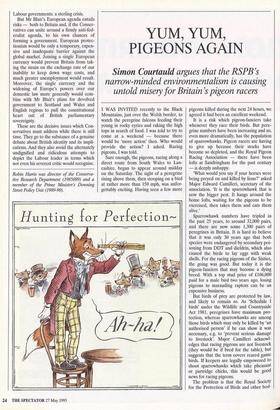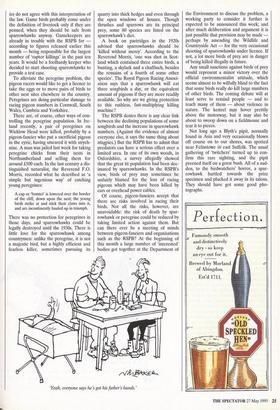YUM, YUM, PIGEONS AGAIN
Simon Courtauld argues that the RSPB's
narrow-minded environmentalism is causing untold misery for Britain's pigeon racers
I WAS INVITED recently to the Black Mountains, just over the Welsh border, to watch the peregrine falcons feeding their young in rocky eyries and raking the high tops in search of food. I was told to try to come at a weekend — because there would be 'more action' then. Who would provide the action? I asked. Racing pigeons, I was told.
Sure enough, the pigeons, racing along a direct route from South Wales to Lan- cashire, began to appear around midday on the Saturday. The sight of a peregrine rising above them, then stooping on a bird at rather more than 150 mph, was unfor- gettably exciting. Having seen a few more pigeons killed during the next 24 hours, we agreed it had been an excellent weekend.
It is a risk which pigeon-fanciers take whenever they race their birds. But pere- grine numbers have been increasing and so, even more dramatically, has the population of sparrowhawks. Pigeon racers are having to give up because their stocks have become so depleted, and the Royal Pigeon Racing Association — there have been lofts at Sandringham for the past century — is deeply unhappy.
`What would you say if your horses were being preyed on and killed by lions?' asked Major Edward Camilleri, secretary of the association. 'It is the sparrowhawk that is now the bigger pest. It hangs around the home lofts, waiting for the pigeons to be exercised, then takes them and eats them alive.'
Sparrowhawk numbers have tripled in the past 25 years, to around 32,000 pairs, and there are now some 1,300 pairs of peregrines in Britain. It is hard to believe that it was only 30 years ago that both species were endangered by secondary poi- soning from DDT and dieldrin, which also caused the birds to lay eggs with weak shells. For the racing pigeons of the Sixties, the going was good. But today it is the pigeon-fanciers that may become a dying breed. With a top stud price of £106,000 paid for a male bird two years ago, losing pigeons to marauding raptors can be an expensive business.
But birds of prey are protected by law, and likely to remain so. As 'Schedule I birds' under the Wildlife and Countryside Act 1981, peregrines have maximum pro- tection, whereas sparrowhawks are among those birds which may only be killed by 'an authorised person' if he can show it was necessary, e.g. to 'prevent serious damage to livestock'. Major Camilleri acknowl- edges that racing pigeons are not livestock (they would be if bred for the table), but suggests that the term covers reared game birds. If keepers are legally empowered to shoot sparrowhawks which take pheasant or partridge chicks, this would be good news for racing pigeons. The problem is that the Royal Society for the Protection of Birds and other bod- ies do not agree with this interpretation of the law. Game birds probably come under the definition of livestock only if they are penned, when they should be safe from sparrowhawks anyway. Gamekeepers are already in trouble with the RSPB for according to figures released earlier this month — being responsible for the largest number of 'raptor killings' in the past ten years. It would be a foolhardy keeper who decided to start shooting sparrowhawks to provide a test case.
To alleviate the peregrine problem, the pigeon racers would like to get a licence to take the eggs or to move pairs of birds to other nest sites elsewhere in the country. Peregrines are doing particular damage to racing pigeon numbers in Cornwall, South Wales, Cumbria and Yorkshire.
There are, of course, other ways of con- trolling the peregrine population. In Ire- land recently, a pair of peregrines on Wicklow Head were killed, probably by a pigeon-fancier who put a sacrificial pigeon in the eyrie, having smeared it with strych- nine. A man was jailed last week for taking peregrine chicks from their nests in Northumberland and selling them for around £500 each. In the last century a dis- tinguished naturalist, the Reverend F.O. Morris, recorded what he described as 'a simple but ingenious way' of catching young peregrines: A cap or 'bonnet' is lowered over the border of the cliff, down upon the nest; the young birds strike at and stick their claws into it, and are incontinently hauled up in triumph.
There was no protection for peregrines in those days, and sparrowhawks could be legally destroyed until the 1930s. There is little love for the sparrowhawk among countrymen: unlike the peregrine, it is not a majestic bird, but a highly efficient and fearless killer, sometimes pursuing its quarry into thick hedges and even through the open windows of houses. Though thrushes and sparrows are its principal prey, some 80 species are listed on the sparrowhawk's diet.
A book on partridges in the 1920s advised that sparrowhawks should be `killed without mercy'. According to the Reverend Morris, 'one was shot in Scot- land which contained three entire birds, a bunting, a skylark and a chaffinch, besides the remains of a fourth of some other species'. The Royal Pigeon Racing Associ- ation says that a sparrowhawk will eat three songbirds a day, or the equivalent amount of pigeons if they are more readily available. So why are we giving protection to this ruthless, fast-multiplying killing machine?
The RSPB denies there is any clear link between the declining populations of some songbirds and the increase in sparrowhawk numbers. (Against the evidence of almost everyone else, it says the same thing about niagpies.) But the RSPB has to admit that predators can have a serious effect over a limited area. In one of its own woods, in Oxfordshire, a survey allegedly showed that the great tit population had been dec- imated by sparrowhawks. In the RSPB's view, birds of prey may sometimes be unfairly blamed for the loss of racing pigeons which may have been killed by cars or overhead power cables.
Of course, pigeon-fanciers accept that there are risks involved in racing their birds. Not all the risks, however, are unavoidable: the risk of death by spar- rowhawk or peregrine could be reduced by taking limited action against them. But can there ever be a meeting of minds between pigeon-fanciers and organisations such as the RSPB? At the beginning of this month a large number of 'interested' bodies got together at the Department of `Yeah, everyone says he's got his father's hands.' the Environment to discuss the problem, a working party to consider it further is expected to be announced this week; and after much deliberation and argument it is just possible that provision may be made perhaps by amending the Wildlife and Countryside Act — for the very occasional shooting of sparrowhawks under licence. If not, a lot more birds of prey are in danger of being killed illegally in future.
Any small sanctions against birds of prey would represent a minor victory over the official environmentalist attitude, which seems almost to be wilfully blind to the fact that some birds really do kill large numbers of other birds. The coming debate will at least serve to remind people — and to teach many of them — about violence in nature. The kestrel may hover prettily above the motorway, but it may also be about to swoop down on a fieldmouse and tear it to pieces.
Not long ago a Blyth's pipit, normally found in Asia and very occasionally blown off course on to our shores, was spotted near Felixstowe in east Suffolk. The usual gathering of 'twitchers' turned up to con- firm this rare sighting, and the pipit preened itself on a gorse bush. All of a sud- den, to the birdwatchers' horror, a spar- rowhawk hurtled towards the prize specimen and plucked it away in its talons. They should have got some good pho- tographs.



































































 Previous page
Previous page